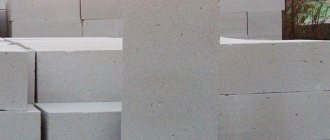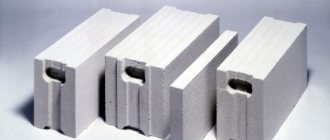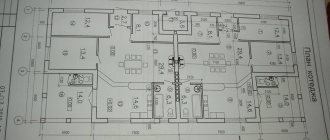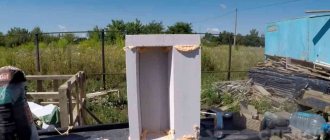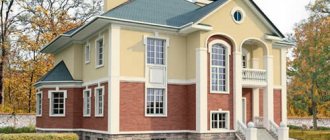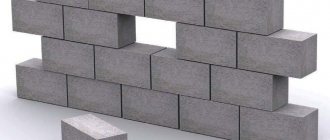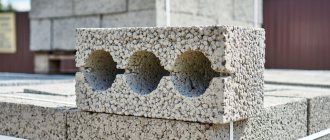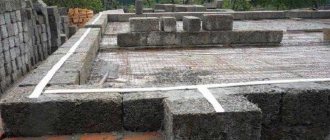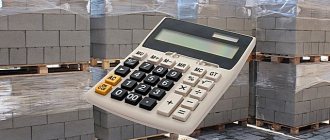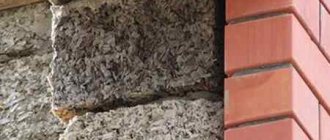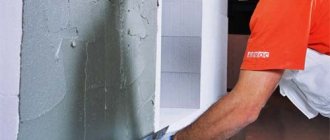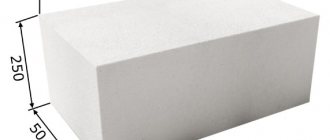So, what are gas silicate blocks?
People paid attention to the increase in the number of useful properties of concrete at the beginning of the 20th century. But only by the mid-50s, production technology had stepped far forward, and gas silicate blocks began to attract attention in the construction industry. It was at that time that a technological leap ensured the future of aerated concrete blocks, whose popularity is only increasing to this day.
A little theory, the composition used in the production of the block:
- Cement.
- Quartz sand.
- Lime.
- Aluminum powder (I’ll tell you a secret that this ingredient is the culprit for the appearance of those very air pores).
Gas silicate blocks belong to the category of conventional cellular concrete. The production method of these blocks is very complex and technological: therefore, in order to produce gas silicate, it is necessary to use a large number of components. Meanwhile, the main ingredient is lime and secondary components: quartz sand, water, cement and a foaming element, which, in fact, is aluminum powder.
The combination of all elements occurs under the influence of high temperatures and high pressure in special autoclaves. In fact, in this regard, gas silicate blocks are also called autoclaved concrete, and their manufacturing technology is called autoclaving. During the thermal influence procedure, air containers appear in the final material - pores, and they greatly influence the advantages of the new building material.
What are the advantages of gas silicate blocks?
- Environmentally friendly. The Gras company takes a responsible approach to the selection of materials for the manufacture of its products. All components used are raw materials, environmentally friendly natural materials that do not have harmful additives. Grasse gas silicate blocks are environmentally friendly for people and the environment throughout their entire service life.
- Strength. The structure of the gas silicate block is essentially concrete with a large number of evenly spaced air pores. The precisely concentrated density of these pores guarantees the strength and reliability of the structure being built. For laying silicate blocks, a special glue is used; it connects individual blocks together without forming a so-called “cold bridge”; the seam is small, up to 3 mm in thickness.
- Practical geometry. The production of blocks is a highly precise, scientifically verified process. Each gas silicate block is identical to each other, which ensures problem-free masonry. The verified size and shape of each block facilitates the design and construction of any building with minimal time.
- Ease of processing. Gas silicate material is unpretentious in processing with almost any available tools: saws, cutters, drills, etc. The finished block can be given any desired shape, which allows you to create buildings of various architectures.
- Fire resistance. Due to their inorganic composition, gas silicate blocks are non-flammable material. In buildings where gas silicate blocks are the load-bearing material, or even used as cladding, fire safety increases significantly.
- Heat resistance. Thanks to the air pores from which the material of gas silicate blocks is composed, they have properties of high heat resistance. At the same time, the material is fire-resistant, and the limit of destruction of blocks from fire is very high and comparable to ceramic bricks.
- Economical. Silicate blocks are truly an advanced material; in comparison with brick, cinder block, ceramic blocks and others, this material is lightweight. At the same time, the weight of the material does not in any way affect other properties of the material, such as strength, using this material there is undoubtedly a saving on transportation, as well as on the speed of work, the laying time when using this material is reduced by 2 - 2.5 times.
There are a number of advantages of this material that professionals will never ignore. Just look at the fact that this material combines the properties of materials such as stone and wood. They get ease of processing from wood - a gas silicate block is easy to cut into pieces, drill, and sand. The second advantage of this material, without a doubt, is its lightness, achieved due to the air pores already mentioned above. Gas silicate blocks are lightweight, which means that they can be transported and moved without much difficulty, saving not only on processing equipment, but also on transportation costs.
The main advantage of gas silicate over other materials is the fact that the mineral base of these blocks is not subject to combustion - that is, buildings made from this material are highly fire-resistant, which means that the risk of fire in buildings made of gas silicate is reduced significantly. The porous structure of gas silicate invariably guarantees an excellent level of heat and noise resistance, which is indispensable in residential construction when using this material. Due to the fact that there is air in the cells of gas silicate, such blocks practically do not conduct heat, which means that a comfortable temperature is maintained to a greater extent in buildings built from gas silicate. In addition, low-strength gas silicate blocks are specially designed to be used as a thermal insulation layer!
Aerated concrete blocks "GRAS - Saratov" prices and characteristics
| Aerated concrete block “GRAS”, density D400 (Super-warm. New!!!) |
| 600x250x75, D400 (partition), 160 pcs. on a pallet, price for 1 piece. — 31.50 rub. 600x250x100, D400 (partition), 120 pcs. on a pallet, price for 1 piece. — 42 rub. 600x250x150, D400 (partition), 80 pcs. on a pallet, price for 1 piece. — 63 rub. 600x200x250, D400 (wall), 60 pcs. on a pallet, price for 1 piece. — 84 rub. 600x200x300, D400 (wall), 50 pcs. on a pallet, price for 1 piece. — 100.80 rub. 600x250x300, D400 (wall), 40 pcs. on a pallet, price for 1 piece. — 126 rub. 600x200x375, D400 (wall), 40 pcs. on a pallet, price for 1 piece. — 126 rub. 600x250x375, D400 (wall), 32 pcs. on a pallet, price for 1 piece. — 157.50 rub. |
| Cost 1 cubic. m of blocks with a density of D400 - 2800 rubles. |
| Aerated concrete block "GRAS", density D500 |
| 600x250x75, D500 (partition), 160 pcs. on a pallet, price for 1 piece. — 32.60 rub. 600x250x100, D500 (partition), 120 pcs. on a pallet, price for 1 piece. — 43.50 rub. 600x250x150, D500 (partition), 80 pcs. on a pallet, price for 1 piece. — 65.25 rub. 600x200x250, D500 (wall), 60 pcs. on a pallet, price for 1 piece. — 87 rub. 600x200x300, D500 (wall), 50 pcs. |
| Cost 1 cubic. m of blocks with a density of D500 - 2900 rubles. |
Aerated concrete blocks are becoming more and more popular every year. Many developers choose them as wall material for their future home.
Aerated concrete blocks, like all building materials, have their advantages and disadvantages. To avoid regrets later, you need to familiarize yourself with them in advance. After all, load-bearing structures of buildings will also be built from aerated concrete, the strength of which will become the basis of your own home.
Classification of aerated concrete blocks, by grade, depending on density
- D300-D500
– thermal insulating aerated concrete - D500-D900
– structural and thermal insulating aerated concrete - D1000-D1200
– structural aerated concrete
Strength of aerated concrete
Despite its lightness, the material has the highest possible strength. Aerated concrete is an ideal compromise between strength, lightness and optimal thermal insulation. Depending on the brand of aerated concrete (300-600), its compressive strength ranges from 1.5 to 3.5 kgf/cm2.
Ease of processing aerated concrete blocks
Easy processing of aerated concrete is an undeniable advantage. It can be cut and sawed effortlessly with simple hand tools, resulting in blocks of standard and custom sizes and shapes. In a dry state, the thermal conductivity coefficient of aerated concrete is 0.12 W/m°C.
Thermal insulation properties of aerated concrete
Aerated concrete blocks of the D600 and D500 brands are a structural and thermal insulation material with low thermal conductivity. This allows the walls to provide reliable thermal protection in winter. In summer, a building made of aerated concrete blocks does not overheat. It maintains the optimal temperature for living.
Soundproofing properties of aerated concrete
The ability of aerated concrete blocks to dampen sounds depends on the brand, the thickness of the aerated concrete mortar, the thickness of the walls and, to some extent, on the technology of their laying.
Fire resistance of aerated concrete
Aerated concrete blocks are a non-flammable material with the highest fire resistance class. Houses whose enclosing and supporting structures are built of aerated concrete belong to the highest (I and II) fire safety levels.
Environmental friendliness of aerated concrete
Measurement of radioactivity of building materials is carried out using a qualification coefficient, which does not have units of measurement and is determined in the laboratory. The radioactivity of aerated concrete blocks is significantly lower than all permissible standards. During operation, aerated concrete does not form toxic components. In terms of environmental characteristics, it is not inferior to natural materials.
Lightness of aerated concrete
The mass of a standard aerated concrete block measuring 625x100x250 mm is 8 kg with an average density of 500 kg/m3. This allows you to significantly reduce solution consumption and shorten construction time.
Resistance of aerated concrete to biological influences
Aerated concrete blocks are an unfavorable environment for the development of mold, fungi and bacteria, which do not appear in them even at a temperature of 30C and an air humidity of 98%. In terms of these indicators, aerated concrete is superior to wood and does not require treatment with antiseptics.
Aerated blocks are a weak base for fastening. Fastening massive objects into aerated concrete walls is quite problematic. Plastic butterfly dowels do not always come to the rescue, unlike self-tapping screws, which screw well and hold perfectly in the walls. But there is a danger of their oxidation, after which they may rust and become unusable. Although there are some fasteners that hold up quite well.
Production of gas silicate blocks
The production of gas silicate blocks using autoclave technology is a labor-intensive technological procedure using specialized furnaces, in which the working mixture is subjected to high pressure and temperature treatment. These ovens are called autoclaves - foaming procedures of the mixture take place in them, under the influence of elevated temperatures of about 200 degrees.
The production process ends with the large blocks leaving the furnaces being divided into small, standard ones. Gas silicate blocks are used not only in the construction of load-bearing walls. In addition, they are useful in the construction of lintels, partitions, etc. The density of gas silicate material can reach 600-700 kg/m3. Low-density gas blocks are recommended when sound insulation and insulation of external walls are necessary. The production of gas silicate blocks necessarily includes an autoclaving procedure, which gives the material strength.
In conclusion of all that has been said, one cannot fail to mention the main fact and advantage of such blocks - their increased safety margin, which is achieved due to the elements used in strict proportion, compliance with all processing and autoclaving rules, as well as the structure of the internal pores of gas silicate blocks. The group produces gas silicate blocks of any size and purpose - both wall and partition. It is integral that all products have passed the appropriate certification, as well as comprehensive control for compliance with the necessary standards in laboratory conditions, such blocks have an ideal block geometry, which greatly facilitates construction - these are the rules that we strictly follow in the production of gas silicate. You can order building materials in any required quantity and at an affordable price either by phone or at any of our retail sites.
Wall aerated concrete blocks
Wall blocks are very popular in the field of low-rise construction.
Each type of block has its own advantages and disadvantages, so before choosing a material for construction, you need to think through all the nuances and consult with specialists. Depending on the composition of the material, building blocks are divided into gas silicate, aerated concrete, wood concrete, kerazit concrete, foam and cinder blocks. The most practical in construction are aerated concrete and gas silicate wall blocks. They can be used both for the construction of load-bearing walls and for zoning the internal space.
